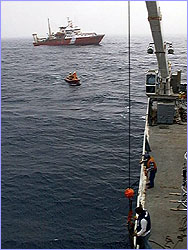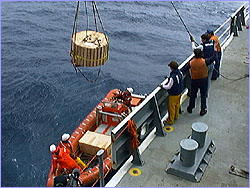
|
 |
 |
by Peter Tyson July 4, 1998 The first piece of news I heard today, Independence Day, was bad, but after that it was smooth sailing. Literally. The wind and waves subsided overnight, and the sun came out, making for a stellar day of science and engineering. Seeing as it's a holiday, I'll leave the bad news for last. Today was all about navigation, and getting closer to the goal of retrieving a black smoker chimney or three from the bottom of the ocean. For those of you who have been closely following this expedition, have you wondered how the researchers here find their way to the clump of sulfide chimneys they hope to study and sample? I mean, we're talking 200 miles out to sea, and then straight down to the seafloor the length of 24 football fields placed end to end. To complicate matters, there are waves and wind and currents. And the place they're trying to get to with the tethered robot and assorted cages lies at the bottom of a steep-sided canyon. Yet these guys manage to place a "package," as they call any piece of equipment they send down on a line, within ten meters of where they'd like to have it—and that's without the "eyes" of ROPOS. How do they do it? With a state-of-the-art system that includes—are you ready for this?—the Global Positioning System, a technique known as dynamic positioning, and a long baseline acoustic navigation system. The first two, GPS and DP, are used to position the ship and the third is used to position the package or to navigate ROPOS. This afternoon I climbed four or five flights of stairs—the Thompson's bridge is 46 feet above the deck—to see the phalanx of computers that do the truly stunning task of determining the ship's exact location (using GPS) and maintaining it (using DP), all in real-time, all within a few tens of feet. The GPS unit works by locking onto up to nine satellites simultaneously and, based on the time difference between its clock and those on each of the satellites, calculating its precise location. Then DP takes over. To maintain the ship's position and heading (supplied by GPS and a gyro compass, respectively), the computers enlist the help of the big bow and stern thrusters. These engines are powerful. The second mate, a gray-bearded man named Eric Schoenberg, told me he was on the Thompson when, as a test, it did a full stop while going 17 knots; the ship was at a standstill one ship-length later. By being able to push water in any direction, the thrusters can also turn the ship "on a dime," Schoenberg said. While I was on the bridge, Schoenberg got a call from the ROPOS room. They wanted him to move the ship about 30 feet. Half a minute after Schoenberg punched in the new coordinates, he laughed and said, "And we're there. Did you hold on tight?" I hadn't felt a thing. To position a package or navigate ROPOS on the seabed takes one more step—a long baseline hydroacoustic navigation system. Believe me, it's as daunting as it sounds. "Long baseline" refers to the distance between acoustic transponders used in the system. In our case, there are four transponders suspended 300 to 600 feet off the seafloor about a mile from the Mothra field. They form an acoustic net that enables "hydroacoustic navigation"—that is, using the speed of sound underwater to navigate.
Such minute positioning of the ship, the package, and ROPOS underlay our successes today. First we placed the line baskets on the seafloor. Each of these steel cages carries an 8,000-foot line, which will be used to haul the smokers to the surface. From their maps of the Mothra black smoker field, John Delaney and Le Olson knew they wanted to drop the baskets 20 meters west and south, respectively, of Phang, the first black smoker they plan to retrieve. Using the expedition's tripartite positioning, they were able to do that, as was confirmed later during a visit by ROPOS. The positioning also facilitated the first successful ROPOS dive in days. Among other accomplishments, ROPOS prepared Phang for removal: placing the metal frame over the chimney, cinching down the frame's wire cables tightly around the structure, and cutting it most of the way through with the modified underwater chainsaw. Tomorrow Delaney's team will try to lift the chimney free of its subterranean home. Will we shortly see our first black smoker on the deck of the Tully? If our luck keeps up the way it did today, then perhaps. The final triumph of the day was transferring a new ROPOS tether from the Tully, which arrived back on-site this morning from its good-samaritan mission. The Thompson sent its zodiac over to pick up the tether, a 1,000-foot line wound around a wooden drum. As I watched the zodiac slowly cross the half-mile or so between the two ships, I wondered why it was taking so long. Only after the Thompson's crew managed to wrestle the thing on board did I learn that the tether weighed 1,200 pounds. For the 30 members of the scientific party, this Fourth of July has been a cause for celebration—all save for the bad news. When I sat down to breakfast in the mess this morning, my eye caught a terse message scrawled in black ink on the bulletin board. It concerned the fishing vessel whose mayday we answered two days ago: "FYI, the F/V Ocean Roamer sank on way to port. ALL HANDS SAFE." Turns out the Coast Guard had battled all night to stop the leak, but the sea had won in the end. The boat sank about noon yesterday. Peter Tyson is Online Producer of NOVA. The Tug of the Thompson (June 23) The ROPOS Guys (June 25) In the Juan de Fuca Strait (June 27) Special Report: A Visit To Atlantis (June 29) Dive 440 (July 1) Rescue at Sea (July 2) What's Your Position? (July 4) Phang! (July 5) 20,000 Pounds of Tension (July 8) Four for Four (July 11) Thrown Overboard (July 13) Was Grandma a Hyperthermophile? (July 15) Swing of the Yo-Yo (July 18) The Mission | Life in the Abyss | The Last Frontier | Dispatches E-mail | Resources | Table of Contents | Abyss Home Editor's Picks | Previous Sites | Join Us/E-mail | TV/Web Schedule About NOVA | Teachers | Site Map | Shop | Jobs | Search | To print PBS Online | NOVA Online | WGBH © | Updated October 2000 |
 Zodiac, carrying tether, approaches from the Tully.
Zodiac, carrying tether, approaches from the Tully.
 Lifting the tether from the zodiac to the Thompson.
Lifting the tether from the zodiac to the Thompson.